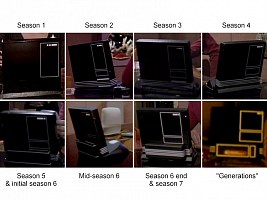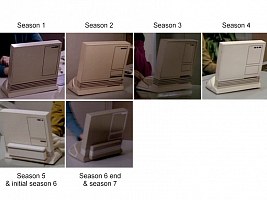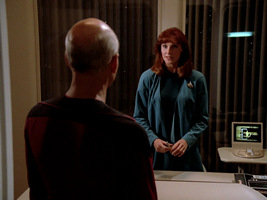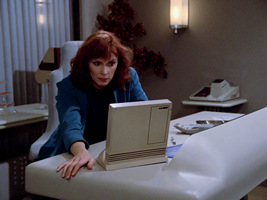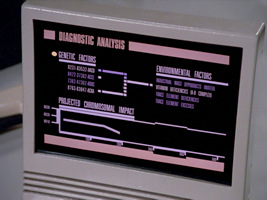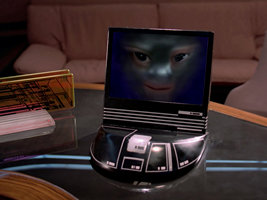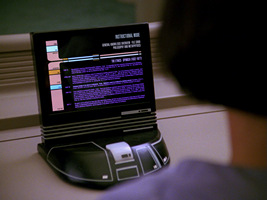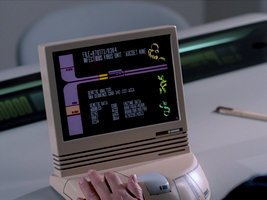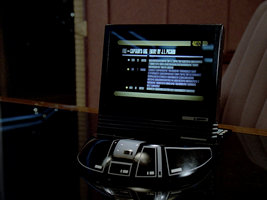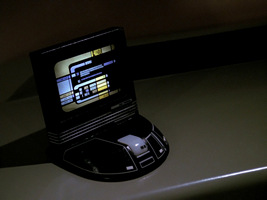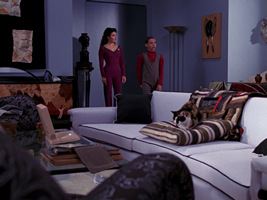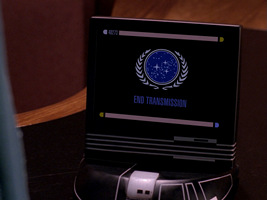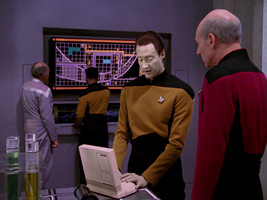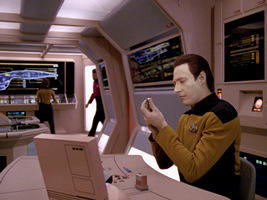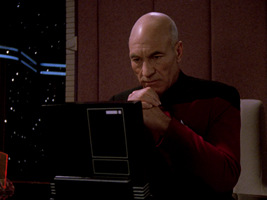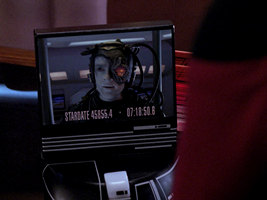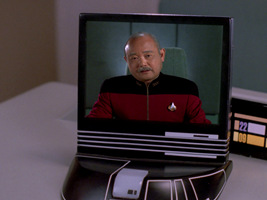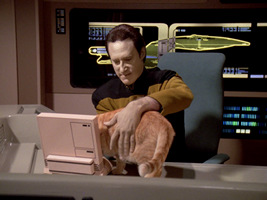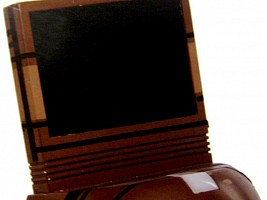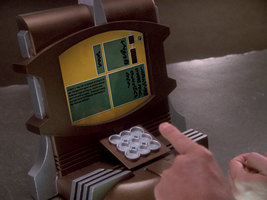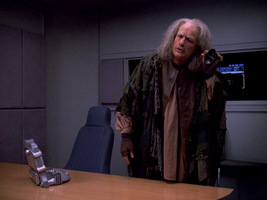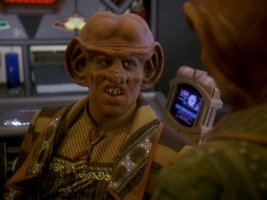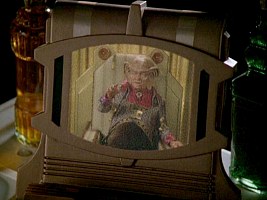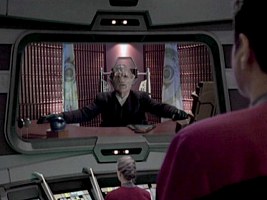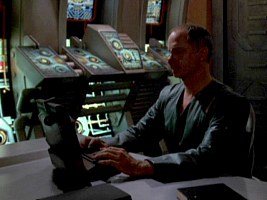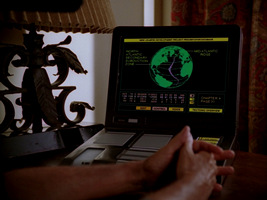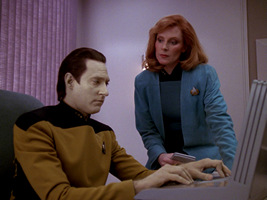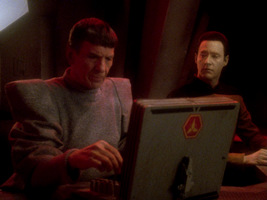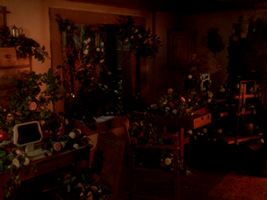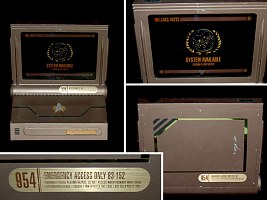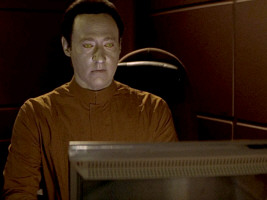Variations of the TNG Desktop Monitor
by Jörg Hillebrand and Bernd Schneider
1 TNG Federation Monitor2 Alien Variations3 Other TNG Monitors4 TNG Movie Monitors
For starters, there is no consistent name for the device under investigation, the desktop monitors of the 24th century which look like present-day laptop computers. Regardless of the nature of the device which, by a 21st century definition, could be either a fully-fledged computer or just a terminal/viewer with a control interface, different designations show up in dialogues, like "monitor" in TNG: "Ensign Ro" or "terminal" in TNG: "Unification I". The screenplays refer to it as a "computer", "computer terminal", "desktop terminal", "desktop monitor", "desktop computer" or "desktop viewer". At Memory Alpha an agreement has been achieved to call it "desktop monitor", and we will follow this suggestion in our article.
An important point of interest is that each of the three basic models which existed over the years can be attributed to a specific series:
- The TNG model (this article) served as a Federation monitor just in TNG. For ten years it spawned countless alien variants, in TNG as well as in other Star Trek series.
- The second one is the DS9 model which was modified to alien monitors likewise of which some appeared in Star Trek Voyager too.
- Finally, there is the Voyager monitor as the only one that could not be seen outside the Federation, not even in a heavily modified variant.
One common characteristic of all monitors is particularly noteworthy: Although they look like the display could be easily flipped down like on present-day laptops, this is never shown in any episode (except for different and more recent designs in the TNG movies). As it appears, the monitors are rigid and not exactly space-saving devices.
A number of further monitors were constructed for the three series. They sometimes appeared in more than one series, but overall less frequently than the three main models of which more than just one or two copies seemed to exist.
The following analysis is limited to the standard desktop monitors of TNG and its alien variants, including the additional devices developed for the series and the TNG movies.
The numerous variations of the this type of monitor will be scrutinized, including the frequent "upgrades" of the Federation model over the years as well as re-painted or otherwise modified props that served as monitors of various alien civilizations. Furthermore we will occasionally draw attention to bloopers and oddities pertaining to the look and operation of desktop monitors. New HD screen caps are shown unless a distinction of the original TV episode and the Blu-ray release is useful.
1 TNG Federation Monitor
This article deals with the TNG desktop monitor. The monitor makes its debut as soon as in TNG: "Encounter at Farpoint". It can be seen for the last time in "Star Trek Generations". There is no cross-over with any other Star Trek series as far as its appearances as a Starfleet device are concerned. The alien monitor derived from it and described further below, however, may have been re-used more frequently than the infamous Varon-T disruptor.
It is possible to distinguish two basic color variants of the TNG Federation monitor. The black model is visible in the captain's ready room and in the crew quarters of Riker and Data, to name a few typical examples. The white variant shows up mainly in sickbay, as well as in Counselor Troi's quarters and her office. There are exceptions to this rule of thumb, which will be pointed out in the following.
1.1 TNG: Encounter at Farpoint
The very first time that we are shown the black monitor is in the ready room beside the Enterprise's battle bridge in TNG: "Encounter at Farpoint". Some time later in the same episode we can also make out Dr. Crusher's white monitor, albeit in an unusual place, on a small table behind her main desk.
The black model still looks somewhat different than in later installments of season 1. Its main switch, in the middle of the base casing, is black here as opposed to white as in every other episode. Also, the switch is labeled with a white number "390" unlike it will later be the case. Furthermore the white stripes on the base are somewhat dissimilar to later appearances.
It is not really recognizable, but possibly the bright monitor sports a label on the switch likewise. As we can see later, there will be no number in this place on the white model, but three vertical black bars, just like on the black monitor. The lines which form two box outlines on either side of the switch won't be symmetrical any more on future versions of this monitor.
A remarkable property of the display (and probably of all other LCARS screens) can be noticed as early as in the very first episode: the number 40271 on the top of the display area. This is the production number of the TNG season as it can be found in every script. The first season was 40271, whereupon the number was raised by 1 for every subsequent year. This allows to identify the season in which a LCARS screen appeared (unless it got re-used).
1.2 Season 1
The season 1 monitor is different from the "Encounter at Farpoint" version only because of a modified painting and labeling scheme on the front side. The button is white (on the black as well as the white monitor), and it is adorned by black, horizontally arranged boxes. Furthermore, both models sport a rectangle composed of black and white lines, respectively, on the left side of the base. Inside this frame, on the lower left, we can make out an additional small rectangle. To its right there is a larger area inside which we can find the main switch. Two black or white rectangles are located on the lower right.
We can see one big black or a white rectangle outline on the rear side of the white and the black monitor, respectively. This rectangle encloses two circles and one bar. Four furrows on the lower edge of the rear side can be found on both monitors, running around the screen casing. They are uncolored on the black monitor (which will change in the following season) and black on the white model.
The three basic techniques to fill the display with life can be identified as early as in the first season:
- A video of a person on the other end of the line or other footage is combined with the screen in post-production. This happens for the first time in TNG: "The Battle".
- Computer-generated moving scenes are inserted into the filmed monitor. This is done in TNG: "When the Bough Breaks" for the first time.
- A static image in the form of a slide is put into the screen and lighted from behind. The advantage is that no complicated post-processing is necessary, although such a screen may look quite boring. A backlit screen can be seen for the first time in TNG: "Encounter at Farpoint".
The latter method will bring about several oddities in the future. It happened repeatedly that a slide which was created for a particular episode (and is often easily recognizable as such) remained in the monitor for some time although the display would have no relevance to the later storylines. For example, the graphic with Picard's log entry on the battle bridge reappears on Wesley's monitor in TNG: "The Naked Now" and on Data's display in "Lonely Among Us". In the same episode we can see it once more on Wesley's monitor where it is intended to show "Doctor Channing's theory on dilithium crystals".
But this is not yet the last re-use. The very same slide appears yet again in "Coming of Age" and in "Symbiosis". Another weakness of the backlit principle becomes obvious in several shots, as the lamp usually illuminates not much more than the center of the display. This may be one incentive to modify the monitors beginning with the fifth season, as will be explained later.
Aside from sickbay the white model shows up in Data's and in Beverly's quarters. The black monitor is visible, besides Picard's ready room, in the observation lounge, Beverly's quarters and Claire Raymond's guest quarters in TNG: "The Neutral Zone").
1.3 Seasons 2 & 3
During the shooting break between the first and the second season the two monitor models were repainted in slightly more contrasting colors. But no new elements were added, just a couple of new stripes were painted or stuck onto the surface. Once again, the modifications of the black and the white model are analogous, the only difference being that the contrasting colors are all reversed. Quite consequently, on the black model the four grooves on the rear side are now colored white, according to the painting scheme of the white monitor.
Let us start the closer examination with the main switch. The switch now has two black rectangles on the lower right, of which one is somewhat larger than the other one, this time painted side by side. Below the switch there is an angled outline encompassing one to three small rectangles on its lower right. The left side of the base now sports a large enframed area with two small rectangles, once again on the lower right. To the right side of the switch we can see two more areas and one white stripe. There are two rectangles inside on the lower right side. A black/white vertical stripe is located directly beside this area. Still more to the right there is one last area with two rectangles inside, but this time on the lower left.
Let us now look at the front of the screen area. As already mentioned the furrows are now colored on both models. The new feature is that the upper furrow remains uncolored on the right side. There is a wide stripe above this portion of the deepening, with two small rectangles inside. Below the furrow there a narrow stripe is located. Both these additional stripes occupy exactly the width of the gap in the furrow.
On the rear side of the monitor there is a similar pattern of the four furrows, on the right side as seen from the rear. There is a gap in the painting scheme of the uppermost furrow too, with a narrow stripe below and a wide bar above this gap. The rectangular frame just above the latter bar was divided into two rectangles, with two circles and a bar in the upper one.
When Picard reviews the logbook entries of the USS Yamato in TNG: "Contagion", we can make out the production number 40272 for the first time on a display. The last digit, as already explained, denotes the season. We can see the same shot of the monitor, with the chart of the missions to the Ficus Sector inserted, in "Up the Long Ladder".
Also in TNG: "Up the Long Ladder", we are shown a slide which is faintly backlit. This slide remains in Picard's monitor for almost one year. In all other episodes of this time the screen is either kept empty, or a video or animation is inserted in post-production. In "Yesterday's Enterprise" in the third season we can still see the slide with the number 40272, in a parallel timeline where the dialogues speaks of a "military log" and not the displayed "captain's log" anyway.
The monitor remained essentially unchanged in this third season, except for one slight modification: The interrupted line on the rear side is now continuous. The gap in the corresponding location on the front side remains the same, however. The only modification to the front side is that a thick line was added below the main switch.
TNG: "Sins of the Father" shows the interseasonal slide from "Encounter at Farpoint" once again, including its outdated number 40271.
Finally there is an oddity in TNG: "The Best of Both Worlds I". Admiral Hanson suddenly shows up on a black monitor without white grooves and without any of the other recent modifications since the first season. The simple reason is that the monitor is stock footage from the first season, from "The Battle", to be more precise. We can spot the same shot of the monitor once again in TNG: "The First Duty", where a video image of Adm. Brand will be incorporated. One shot from TNG: "Where Silence Has Lease" was re-used in "Contagion" as well as in "Up the Long Ladder", as already shown.
The white model makes its first appearance outside the Enterprise-D in the second season, more precisely in Captain Donald Varley's ready room aboard the Yamato in "Contagion". Later, we can see the monitor in Marla Aster's house in TNG: "The Bonding".
The white model is visible, besides sickbay, in Data's, Riker's (TNG: "The Enemy") and Deanna's quarters. The black monitor shows up, besides Picard's ready room, in Riker's quarters (TNG: "The Icarus Factor"), Data's quarters and Deanna's office (TNG: "The Price").
1.4 Season 4
Once again there are mostly cosmetic changes to the device at the beginning of the fourth season. It appears that both models were completely repainted in less glossy colors. Especially the black model appears matt in several shots, like in TNG: "Suddenly Human". The number of the small rectangles inside the enframed areas is subject to vary; most of the time there are only one or two small boxes. The biggest modification on the front side is the area on the right between the switch and the big area on the very right. Here we can now find a narrow new field with a small box inside, as opposed to the earlier vertical bar. In addition, the field below the switch was extended upwards, eliminating the bar directly beneath the switch.
On the rear side the lower frame was extended somewhat to the top, making the upper one smaller. Also, the two circles and the box on the upper right were replaced with three about equal bars on the white model and with two different bars on the black model, respectively.
TNG: "Reunion" is the first time that we see an alien language on a Federation monitor. With the Klingon letters the colors change as well, from the yellow/blue LCARS scheme to the red/orange Klingon interface. In the same episode, K'Ehleyr reviews information about the massacre on Khitomer, but is actually looking once again at Picard's old log entry from "Encounter at Farpoint".
Also in "Reunion", Beverly inspects a scan of a Klingon arm. Curiously the image of the monitor was left-right reversed, as here the gap in the upper black groove is on the left.
TNG: "Night Terrors" displays the correct season number 40274, on a graphic of the Tyken Rift. For some reason Picard must be fascinated by this phenomenon, as he still has the same picture on his monitor in TNG: "The Host".
Owing to the anomalies that are encountered in the episode, the monitor falls through the desktop in TNG: "In Theory". We can see the monitor on the floor, with still the same angle between the screen and the panel as in its normal position. This is more evidence for the assumption that it's not possible to close the monitor. Later, in "Redemption I", we can see the monitor for the last time in its original configuration. It will be reworked prior to the next season.
Once again we can see the monitor model outside the Enterprise. The first time in this season is on the ready room of the USS Phoenix in TNG: "The Wounded", then the white variant shows up in the research station on Ventax II in TNG: "Devil's Due".
The white model is visible once more in Deanna's and Data's quarters, in K'Ehleyr's guest quarters, in main engineering and, of course, in Beverly's office. The black model shows up in Picard's quarters, in the Klingon guest quarters in "Reunion", as well as in Riker's illusionary quarters in TNG: "Future Imperfect".
1.5 Season 5
The most extensive modifications of the device took place some time between the fourth and the fifth season. In TNG: "Redemption II" we can see the monitor with a new box attached on the rear side, covering the repeatedly mentioned four furrows. While there is no good in-universe explanation as to why the monitor should be modified (to look even clumsier), the box may serve the simple purpose to hold the batteries for the lighting, thus making cables expendable.
These new "power packs" were added to the black as well as to the white monitor. They sport two stripes in the respective opposite color, one near the upper and one near the lower edge, on all three visible sides.
The number 40275, denoting the fifth season, is readable in TNG: "Unification I". As already reported, we can spot a re-use of the simplistic first-season monitor in TNG: "The First Duty", with Admiral Brand depicted and the monitor being stock footage from TNG: "The Battle".
In "I, Borg" there is a noteworthy scene in the ready room where Picard is watching a monitor with an animation of the Enterprise-D. There is no obvious reason why the animation was created for this trivial purpose, when a static backlit display would have sufficed.
The "personal appointment log" of Deanna Troi as shown in TNG: "Imaginary Friend" reappears on Dr. Crusher's monitor in "The Next Phase". Although it was slightly modified, the text has remained essentially the same.
The white monitor is visible in Beverly Crusher's office, in Deanna's quarters and office, in Ro's quarters and Dr. Kila Marr's quarters. The black variant can be seen in Picard's ready room as usual, as well as in Riker's and Data's quarters.
As the two models are henceforth modified differently, the black and white models will be examined separately in the following.
1.6 Beginning of season 6: black variant
This variant can be seen in "Realm of Fear" and "Man of the People".
1.7 Mid-season 6: black variant
Beginning with TNG: "Rascals", the black monitor was apparently repainted. In a couple of episodes in the middle of season 6 the whole white labeling on its left side is missing. This variant (or blunder?) can be seen in "Rascals", "Chain of Command I", "Aquiel", "Birthright I" and "Lessons". In between we can see a complete and glossy monitor in "Starship Mine", but this is because we are looking at stock footage from "Where Silence Has Lease" (as previously used in "Contagion" and "Up the Long Ladder") with new takes of Orton inserted.
"The Chase" includes a monitor re-use from "Déjà Q" until the new variant shows up in "Second Chances".
1.8 End of season 6 & season 7: black variant
The white frame on the left side is in place again on this variant. In addition, the power pack on the rear side now bears four stripes almost seamlessly continuing the familiar four grooves. We can see this monitor until the end of the series, even in TNG: "All Good Things" in the flashbacks where we would expect the model of season 1.
Stock footage is quite common in this period as well. In "Descent I" we can make out the monitor as it appeared in "Déjà Q", and as it was previously visible in "Lessons".
A close take of the screen as it previously appeared in "Starship Mine" can be seen once more in "Interface" and "Parallels". A particularly noticeable re-use comes to our attention in TNG: "Pegasus". Here not only the interface but even Picard's shoulder is taken from "Déjà Q". The Bre'el IV scientists were replaced with Admiral Blackwell.
The de-evolved Riker tosses a monitor at Picard in TNG: "Genesis". The device breaks apart, plausibly into the upper display part and the base. We can see that the inside of the desktop monitor, at least the basic color of the plastic, is beige.
The black variant is visible, besides the ready room, in Tom Riker's, Geordi's and Worf's quarters and surprisingly in Dr. Crusher's office too. We can see it there when Admiral Nakamura calls in TNG: "All Good Things".
1.9 Beginning of season 6: white variant
The white version with the power pack, as familiar already from season 5, can be seen in the O'Briens' quarters in TNG: "Rascals" and in Data's quarters in TNG: "As Fistful of Datas". The white variant does not show up for a long time afterwards. It was eventually repainted to gray.
1.10 Gray variant
The bright variant was modified a bit more extensively in the middle of season 6. The black monitor was only given back the white lines on the base and the lines on the power pack. The latter were added to the white monitor as well. But the overall color was changed to bright gray, with all new stripes and boxes in white instead of black. We assume that it was the white monitor which was reworked because when the gray one was finally introduced, the white monitor had not been seen for quite a while.
This new monitor has its debut in TNG: "Suspicions" in Dr. Crusher's office. The decoration is the same as on the black model. All lines are white now, resulting in a slight contrast with the somewhat darker overall color. The four furrows are continuous here; the white bar above them includes two black rectangles.
We can also notice the gray monitor in Counselor Troi's office, her quarters and Daniel Kwan's quarters. This monitor didn't make it to "Generations".
1.11 Generations: black variant
In "Generations", we can make out the black monitor on two occasions, in Picard's ready room and later in his quarters. The power pack is still in place. Its rear side was modified though, as the four stripes were replaced with four frames placed side by side, a big one on the left and a small one on the right. Inside the big frame we can see a standard door label, of the kind with usually illegible in-jokes.
This is the last appearance of the TNG Federation monitor. DS9 and Voyager both have their own monitor designs. But the TNG model will be frequently resurrected to act as alien monitors.
Brown variant One TNG monitor was an item in Christie's big Trek auction in 2006. The catalogue says about the prop:
"One prop computer with nonfunctional backlit screen and swivel base - 10x10 in. - this prop was originally painted black and used in the Enterprise-D sets in Star Trek: The Next Generation, it was later repainted and reused for use on a variety of alien ship sets in Star Trek: The Next Generation and Star Trek Voyager. This is the only known surviving Enterprise-D desktop computermonitor prop. In its original form, it was highly-recognizable [sic] part of the look of Star Trek: The Next Generation."
We could not find this very monitor (provided the color is authentic) in any episode so far. As it is only painted brown and not otherwise modified, we assume that it is not any of the following alien variants.
2 Alien Variations of the TNG Federation Monitor
On a couple of occasions we can see alien or other desktop monitors in TNG and the following series. The most frequently re-used model is a modification of the TNG Federation monitor. The prop was supplemented with a number of parts and was repainted over and over, which will become visible towards the end of its lifetime.
2.1 Romulan
The first time we can see the alien variant of the TNG monitor is in TNG: "Unification I & II" on Neral's desk where it is obviously intended to be a Romulan model. Like every of these devices of the fifth season, it is equipped with the battery box on the rear side. Square ribs were added to the top and the two sides of the display portion, as well as to the sides of the base. The actual screen area was decreased in a way that the lateral extensions wouldn't protrude into the image.
The color of the monitor is now typically Romulan turquoise, the ribbed extensions are pale yellow. There are some black lines on the rear side and, as the most noticeable feature, a large red Romulan eagle emblem.
2.2 Cardassian
For its next incarnation the monitor was not only repainted but also reworked. We can see the device as a Cardassian monitor on Gul Madred's desk in TNG: "Chain of Command I & II". The lateral ribs on the base body are still the same, whereas the upper extensions were removed. A rounded frame was put over the actual screen, making it look more alien. Since the Cardassian style was already defined for DS9 when the TNG episode was made, it is no surprise that the TNG monitor follows the lines of the Cardassian monitors on DS9. A counterpart with a congruent outline was attached to the rear, making it look like the rectangular case is built around an oval core of the monitor, rather than the other way round. A new spire adorns the top of the monitor which seems to continue with a small box just below the display. The sides are extended at the base with curved parts.
The overall color is still turquoise; the main switch, power pack and the oval frame are red, while all other new extensions are yellow. The rear side of the rounded screen is framed by a thick black line.
2.3 Baran
The monitor was once again slightly modified for its appearance as Baran's computer in TNG: "Gambit I & II" (curiously yet another two-part episode). The device was given a number of extensions, some permanent and some only for this one episode. The field with the nine small white "soup bowls" will be removed after the episode, whereas two hemispheres, one below the switch and one in the upper half of the rear side will remain on the monitor case.
The whole monitor was painted metallic brown, including the two hemispheres, the power pack and the switch. The lateral ribs at the base and all other extensions are silvery. The rounded outline on the rear side following the lines of the oval frame still exists and is white here.
2.4 USS Pasteur
This monitor shows up in the alternate future of TNG: "All Good Things" in Beverly Picard's ready room. The LCARS sticker on the power pack like on the standard monitor in "Generations" is solid evidence that we are looking at a Starfleet monitor. Yet, no new attachments were created and none were removed. The device was just painted over again.
The basic color is now silver, while the lateral monitor add-ons as well as the spire are now somewhat darker silvery or gray. The wide line on the rear is black again, and the power pack exhibits two black lines as well, just like the regular monitors of the fifth season.
This was the last appearance of the TNG monitor in the series. The whole production staff including all sets, props and costumes was directly transferred to Star Trek Voyager. This is the reason why we find TNG re-uses in Voyager, rather than in DS9 where a lot had to be created from scratch while TNG was still running.
It is no surprise that the TNG monitor soon appeared on Voyager.
2.5 Banean
We can see the device inside Dr. Tolen Ren's house in VOY: "Ex Post Facto".
The monitor was painted completely red, with the exception of some rectangular black regions on the rear and the power pack. Otherwise there are no visible alterations.
2.6 Ocampa
Next, we can see the device as an Ocampa monitor in VOY: "Cold Fire", on Tanis's desk. Here the monitor is gray-blue, and the oval line on the rear side is visible again, now painted light blue/gray. Once again, nothing else was altered.
After that, the monitor didn't show up on Voyager for a couple of years until the sixth season. Perhaps the DS9 people borrowed the prop and didn't return it until the end of the series? Exactly this appears to have happened, as we can see the monitor repeatedly in the third to seventh seasons of DS9.
2.7 Romulan
Enabran Tain is working on a Romulan monitor in DS9: "Improbable Cause", whose colors are similar as the ones in TNG: "Unification" but which retains all modifications that occurred since TNG: "Gambit". The overall color is now beige (also of the power pack), while the oval display and all extensions are teal. In addition there are new black stripes and a Romulan label on the right side of the power pack.
2.8 Ferengi
Once again a few years pass until the prop appears as Quark's Ferengi monitor in DS9: "Business as Usual". The color is, typically of the Ferengi, brown-golden, with a number of somewhat brighter stripes. On the side of the monitor there are two black stripes of the kind that seem to surround the switch as well. The rear side is never visible.
2.9 Farius Prime
Bilby is working on a monitor in DS9: "Honor Among Thieves", which is identical to Quark's variant. One can see the black stripes around the main switch and the hemisphere below which was probably present in "Business as Usual" too, like in a couple of previous episodes. On the top we can make out the two slightly brighter stripes.
2.10 Sloan's mind
Once again without modifications, the monitor appears in "Sloan's mind" just before the brain death of the Section 31 agent in DS9: "Extreme Measures". Nothing has changed since its two previous DS9 appearances. But now we can see the rear side too. There is a wide horizontal line on the power pack, two vertical lines which begin below the hemisphere, as well as two angled lines on either side of the rear panel. The other monitor visible on the left previously appeared in DS9: "Rejoined".
2.11 Ferengi
In DS9: "The Dogs of War" it is up to Quark again to use his unchanged monitor, so 2.8 through 2.11 are the very same variation. We can see the rear side again.
This concludes the appearances of the TNG alien monitor on DS9. After the end of the series the prop was returned to the Voyager staff
2.12 Telsian
The Telsian official Orek is using the monitor in VOY: "Live Fast and Prosper". Once again it seems to be the very same variant as the Ferengi monitor 2.8.
2.13 Bajoran
In "Repression", finally, we can see the device in new colors, this time as a Bajoran monitor in Teero Anaydis's possession.
The color is brown. It becomes evident in the close view that the surface is not as even as it used to be but rather crumbly owing to the many layers of paint. There are a couple of black lines, and blue bars were added to the black frames on either side of the display. On the rear side the oval line is visible again, following the outline of the screen. In addition, there are some horizontal black lines on the power pack.
2.14 Quarra
Eventually the monitor showed up as a Quarra device in VOY: "Workforce II" before it was retired. The monitor is visible only in a shaded area, but it seems that it is the same as Teero's variant with a brown basic color (perhaps still darker here). On the rear side there are the same black stripes as on Teero's device. Moreover, we can witness how the Quarra uses the lateral ribbed extensions like a keypad. He is typing on them, producing beep sounds.
3 Other TNG Monitors
Two more monitors were built during the run of TNG. Both of them were re-used a number of times.
3.1 Picard
This monitor can be seen on three occasions.
The monitor debuts in TNG: "Family". It is the first desktop monitor other than the familiar TNG Federation type. Picard is looking at the plans of the Atlantis Project on such a monitor in his brother's house in France. The monitor sports a large number of small fields and buttons. Its display is quite thick, with a number of grooves running around the sides of the case. We can also notice that the interface is not LCARS but something we could classify as a civilian standard.
Inexplicably the same monitor can be seen when Data reviews data about Tarchannen III in TNG: "Identity Crisis", worrying about his friend Geordi. For some reason he is not using Dr. Crusher's well-known normal monitor but this rather clumsy looking device. Perhaps the reason is that the normal monitor was not available, being still in the main engineering set where Data worked on it on another occasion?
Finally Picard's monitor was rebuilt to a Klingon device for TNG: "Unification I & II". The overall color is now darker gray, with some additional black stripes. On the rear side there is the Klingon emblem, as well as a new irregularly shaped part. Some new protruding keys can be found on the base of the monitor.
The device never showed up again after this modification.
3.2 Klingon
We can see the originally Klingon monitor seven times altogether.
The first appearance of this Klingon monitor is in TNG: "Redemption II" in the hands of the Duras sisters. The characteristic feature of the device is the octagonal screen which sits on an octagonal base. An apparently unchanged monitor reappeared in "Unification II", once again as a monitor of Klingon origin.
In TNG: "Descent I & II", however, we can see the prop as a white Federation monitor. Two black square outlines can be found on its rear side. Felisa Howard possesses such a monitor too, essentially without modifications in TNG: "Sub Rosa". This is the last time that we can see the monitor in TNG.
Right at the beginning of Star Trek Voyager, the formerly Klingon monitor becomes visible in Pa'Nar Makull's office on the "Polaric Power Planet" in VOY: "Time and Again". The base is painted silvery. Shortly after this incarnation the monitor can be seen in Dr. Tolen Ren's office in VOY: "Ex Post Facto" on Banea. It is silvery white, with the characteristic Banean emblem on the rear which can be found in other places on the planet likewise.
After a long time the monitor is visible one final time, still with the colors from "Ex Post Facto". We can see it in the office of the Quarra Ambassador in VOY: "Workforce I". The model is identical to its previous incarnation.
4 TNG Movie Monitors
New monitors were built for each of the three latest TNG movies with the Enterprise-E, and each of them appears exclusively in just one movie.
4.1 First Contact
One of the probably most prominent monitors of Star Trek is the one with the self-opening screen in "Star Trek: First Contact".
4.2 Insurrection I
In "Insurrection" we are shown a decent white monitor with a small base and without any stickers. This monitor type can be seen in Picard's quarters and in his ready room.
4.3 Insurrection II
Furthermore there is a monitor in Counselor Troi's office that is reminiscent of the previous TNG variants on the Enterprise-D. It exhibits an LCARS label on the front side, but it doesn't look like any other model with such a sticker. The monitor ws for the sale in the "It's a Wrap" auction in early 2007 where we could have a much closer look.
4.4 Nemesis I
In "Nemesis" Picard has a monitor whose screen emerges from the desk as soon as a call arrives.
4.5 Nemesis II
In addition, there is a flatscreen monitor with a small base in the quarters of Data and Riker, as well as in Picard's office (not his ready room). We can identity it as a modified commercial screen because of the ventilation slots. Data's monitor is golden, the ones of Riker and Picard are silvery.
This concludes the analysis of all monitors that were developed for TNG and the TNG movies.
See Also
Variations of the TOS Desktop Monitor - investigation of its evolution and all variants, including TOS-like monitors in ENT and SNW
Variations of the DS9 Desktop Monitor - investigation of its evolution and all variants, including other monitors of the series
Variations of the VOY Desktop Monitor - investigation of its evolution and all variants, including related monitors
Re-Used Props - Mobile Computers - desktop computers, handheld computers
Credits
HD screen caps from TrekCore and Ariane's Star Trek Gallery.







 Black variants at a glance, front side
Black variants at a glance, front side